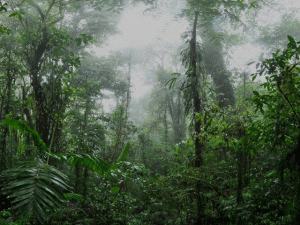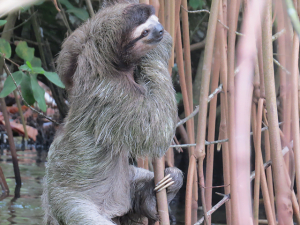Costa Rica has some of the most beautiful national parks to visit in the World. With great biodiversity and impressive landscapes. So we present to you, four of the most famous parks in our beautiful country.
Manuel Antonio National Park:
The Manuel Antonio National Park is one of the most visited parks in Costa Rica. The incredible Punta Catedral was, at some point, an island off the coast. After years and years, the sedimentation filled in the land with sand, connecting everything with the mainland. The locals put a name to this stretch and it is Tombolo Beach.
The cliff rises from the shoreline, giving impressive views and hiking trails. The forest hillsides are the home to lots of birds, animals, and flowers that are unique in Costa Rica, such as Monkeys, iguanas, sloths, toucans, and scarlet Macaw.
The islands of Manuel Antonio give refuge for sea birds, Mogote and Olocuita are nesting and mating sites for frigate birds, anhingas, and brown pelicans.
There are 3 primary beaches in Manuel Antonio National Park; Puerto Escondido, Espadilla Sur, and Manuel Antonio. Rio Naranjo forms the southern border of the National Park.
Braulio Carrillo National Park
The Braulio Carrillo National Park has lots of dormant volcanoes; Cerro Cacho Negro, Cerro Chompipe, Cerros las Tres Marias, and the Barva Volcano which gives crater lakes: Danta, Barva, and Copey.
The park is essential for the protection of the water supplies of the Sector Norte hydroelectric project, which provides water to a great portion of the central valley.
The rainforest and the primary cloud forest, which has lots of fauna and flora species with multiple life zones, waterfalls, and innumerable rivers.
Tortuguero National Park
The Tortuguero National Park is one of the most visited parks in Costa Rica. It’s attractive wilderness areas with a great amount of life are the highlight. The wildlife is diverse and rich, with eleven habitats. These include littoral woodland, high rainforest, slope forest, holillo forest, swamp forest, herbaceous Lagoon, and herbaceous swamp. Birds, mammals, and fish are numerous.
The environments for which Tortuguero are known are the coastal and marine areas. Strop currents of the Caribbean have provided a long straight that expands the beach and it’s the favorite area for turtles to nest. Loggerheads, Hawksbill, and pacific green turtles nest from July to October. The largest sea turtle, leatherback, nest from February to July.

Water is abundant in the area with up to 240 inches of rainfall per year. An incredible number of interconnected channels, lagoons, waterways, and lakes are fed by rivers that carry their inland sediment load to the coast. Sometimes, the sediment-filled plain is interrupted by a forested rolling hill, which is composed of old ancient volcanic cinder cones, like the Tortuguero Hills and the Lomas de Sierpe.
At the very north of the National Park is the Barra del Colorado Wildlife Refuge, whose climate and habitat are like Tortuguero.
In the south end, the national park is bordered by the Parismina River and the Cariari National Wetlands.
Corcovado National Park
The Corcovado National Park is an amazing experience where to visit, in the park is the drainage of Corcovado Basin, a broad sediment-filled oceanic embayment between Punta Rio Claro and Punta Llorona, which extends into the land from the Pacific Ocean 2-10 km eastward. This is dominated by meandering rivers and creeks.

Three toad Sloth
The rocky uplands, where produced by intensive tectonic activity and weathering, all dominated by narrow ridges and long slopes, with dense drainage networks.
The National Park is an uninterrupted beach that extends for 20 km, with pocket beaches and cliffs at the southern and northern park headlands, there is a cave near the southern point.
Source: National Park






